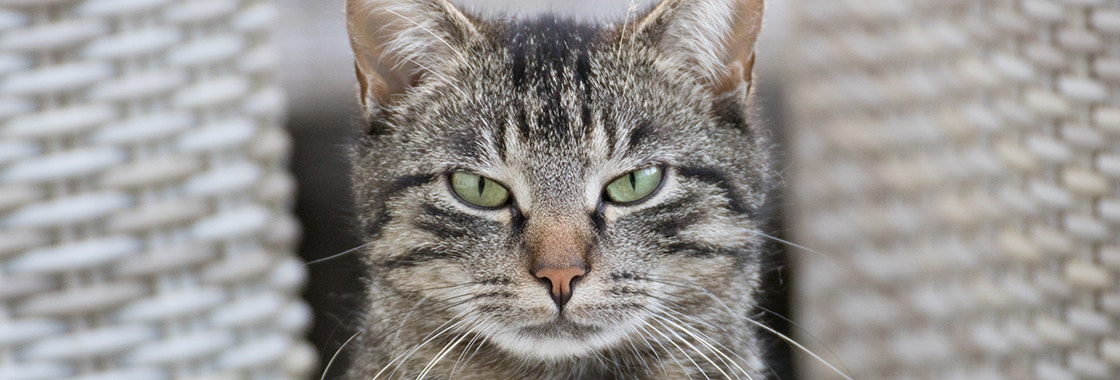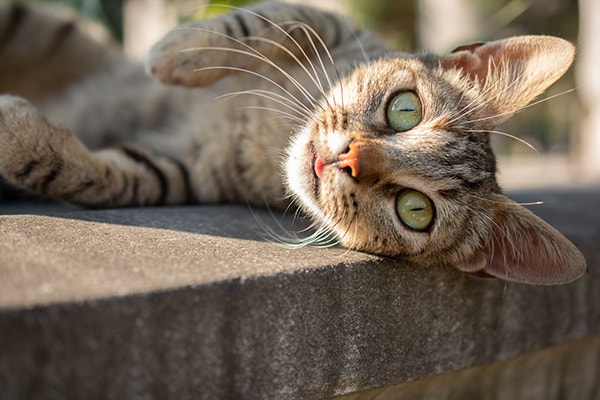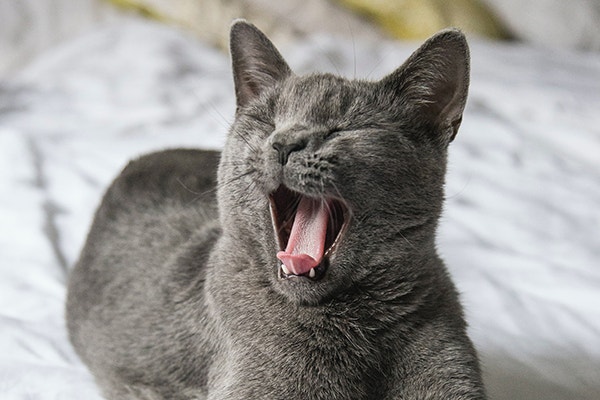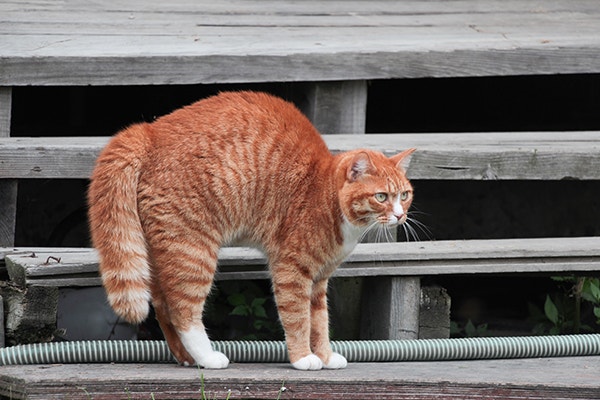Why Do Cats Growl? Understanding Cats Behaviour


Share
Cat parents hear their cats make all sorts of sounds, but one that may cause concern is your cat growling. Your cat may growl at you, a kitten or at other cats, or your cat may growl when eating, being touched or at nothing in particular. If you’re wondering ‘why is my cat growling all of a sudden?’, the simple answer is that cats growl to warn you about their discontentment. It’s important for cat parents to understand what their cat is unhappy about in order to improve the situation and prevent more aggressive behaviours.
In this article, we look at the various reasons why cats growl, including behavioural and physical factors. We help cat parents know how to respond to their cat’s growling and which common mistakes to avoid. With guidance, cat parents can begin to understand their cat’s communication methods, and support them in the way that they need.
Why do cats growl?
The sound of a cat growling is created by them pushing air through their vocal cords, creating a deep and low rumble. Growling is a normal behaviour when cats experience a trigger and want to communicate their discontentment. Just as there are various reasons why cats purr, cats can growl to communicate when they’re feeling pain, anger, fear or territorial, as well as physiological reasons.
Cat parents can learn more about their cat’s growling behaviour by observing their body language at the time. If your cat is feeling angry or frightened, you may notice their back is arched, ears are pulled back, pupils are constricted, fur is standing up and tail is swishing aggressively. Other signs of aggression include your cat hissing or spitting. Either way, a growling cat is a warning for the person or animal present to back off - before things escalate to biting and scratching.
Behavioral factors that cause cat growling
Cats can growl due to various behavioural factors, including fear, overstimulation, territoriality or instinct, and we discuss each of these in more detail below.
Cats may growl out of fear
Cats are creatures of habit, so if there is a change in their routine or environment, your cat may feel anxious or afraid. This could be the presence of a new person or pet in the house, and your cat may growl when touched to dissuade them. Cats who are experiencing fear may also have their ears and whiskers held back, back arched and fur and tail standing up. Cat parents should identify the trigger for their cat’s fear and try to remove the source if possible. If it can’t be removed, cat parents can help their cat feel safe by establishing boundaries around their personal space.
Cats may growl if they feel overstimulated
Cats can sometimes feel overstimulated when playing, and may misinterpret rough play as a sign of aggression. If your cat is growling at you during playtime, this is usually to communicate they are no longer enjoying the session and want you to stop. If your cat’s ears and whiskers are held back, their pupils are dilated, their tail is between their legs and they’re crouched down ready to pounce, they’re likely feeling defensive and need space.
Cats may growl to establish territory
Cats are territorial creatures, so if your cat is growling at other cats, it’s usually a way to assert their dominance and warn their opponent to not enter their space. Generally, before cats fight, they engage in a standoff and expect the other cat to back down - and cats growling at each other is one way to achieve this. Your cat may show other signs of aggression, such as hissing and spitting. While this behaviour can help maintain a social hierarchy in multi-cat households, it can be difficult if your cat is growling at a new kitten.
Cats may growl to protect their resources
Similarly to how cats protect their territory, they also instinctively protect their essential resources such as their food, water and belongings. If your cat is growling at other cats, it could be to establish that their resources are not to be touched. You should always keep your cat’s belongings separate from other pets in the house, to avoid aggressive behaviours.
Cats may growl as a warning
Whether the trigger is inciting fear or anger in your cat, the reason why cats growl is always a warning. Although it may seem like your cat is growling at nothing, they may be uncomfortable with the interaction or situation, and cat parents should heed this warning and give their cat space. If ignored, your cat’s growl can escalate into biting or scratching, potentially endangering you, another person or an animal.
Physical Reasons for Cat Growling:
An important part of caring for a cat includes trying to understand their behaviours in order to detect any changes. We look at the physical factors that may be causing your cat to growl all of a sudden below.
A cat's growling could be a sign of discomfort
Cats are stoic creatures, which means they are skilled at hiding their pain and discomfort. Sometimes, the only sign cat parents may observe is a change in their cat’s behaviour - such as increased aggression exhibited through growling. There are many potential health issues that could be affecting your cat, but the most common include dental problems, internal or external parasites, and urinary tract infections. If your cat is injured, they may also growl when you touch the affected area. If you suspect your cat is in pain or discomfort, contact a veterinarian to rule out any underlying medical conditions.
A cat's growling could be due to maternal instincts
While we’ve discussed how cats are territorial over their space and resources, they are also protective over their kittens. If your growling cat is a mother, this is likely due to her maternal instincts. Your cat may even growl at you as a way to keep her kittens safe from any potential threats; even if she is familiar with you, her instincts will take over.
A cat's growling could be because of hormonal changes
A growling cat could also be affected by their hormones. Cats who are unspayed or unneutered may display signs of aggression such as growling, especially when they are in heat (mating season) due to fluctuating hormones. Your cat may growl at you or at other cats - for example, unneutered male cats will growl at each other to assert their dominance.
How to respond to your cat's growling ?
Make sure your cat has a comfortable and safe environment
It’s important that cat parents know how to respond to a growling cat, in order to keep their cat, themselves and others safe. Your immediate response should be to leave your cat alone, but we discuss this in more detail below.
Give your cat space
A growling cat is usually warning you to leave them alone. In this case, you, or anyone else present, should respect their wishes and provide some personal space for them to calm down. If you have children, you should also teach them to immediately leave a cat alone if it growls, for their safety.
Address the trigger
If something or someone is causing your cat to growl, such as a stranger in the house, then respectfully remove the trigger from your cat’s space. In situations where this is not possible, you can reduce your cat’s exposure to the trigger.
Rule out health issues
If you suspect your cat is experiencing pain or discomfort from an injury, dental or medical issue, take your cat to the veterinarian to improve the underlying cause of their aggressive behaviour.
Make your cat feel safe
Creating a safe environment for your cat can help them feel more comfortable. Make sure your cat has a private space they can retreat to when they feel overwhelmed.
Don’t try to comfort them
A cat’s growl means they want to be left alone, so don’t try to comfort an aggressive cat as this can cause things to escalate. In the heat of the moment, they may see your attempts to comfort as a threat.
Never punish your cat
Cats growling is a normal communication method to inform you of how they feel about the situation. You should never punish your cat, as this will lead to more aggression and may create distrust between you.
Common mistakes to avoid
Sometimes, it can be difficult for cat parents to know what it means when a cat growls, and how to respond to it. The most common mistake that cat parents make when a cat growls is ignoring the warning. If the trigger continues, your cat’s aggressive behaviour may escalate. You should observe your cat’s body language to try and identify which emotion they are feeling, in order to discover the cause. You should not approach a growling cat or continue to interact with them, once they've vocalised their displeasure, and you should never punish a cat for growling, as this is their way of communicating. If you want to get a cat to like you, try to understand their body language and vocal cues, so you can respond appropriately.
Cats engage in many behaviours, and it can take time for cat parents to understand what they are trying to communicate. If you're ever concerned about your cat’s growling, it’s best to consult a veterinarian so they can check your cat for any underlying health issues, or otherwise refer you to a cat behaviourist. Apart from growling, cats may also lick you - a non-aggressive but still peculiar behaviour that you can learn more about.
WHY DO CATS GROWL: FAQ
Is it normal for cats to growl at you?
Yes, it’s normal for cats to growl at you if they are not happy with their situation. This could be because they’re feeling afraid, stressed, or overwhelmed. Your growling cat is trying to communicate how they’re feeling and usually will want to be left alone.
Why is my cat growling but not angry?
If your cat is growling but not angry, they could be experiencing fear, pain, or an underlying health issue. There may not always be an obvious trigger to why your cat growls, and in this case, it’s best to consult a veterinarian to rule out any health issues.
Why do cats growl when petted?
Cats may growl when petted because they’re not in the mood to receive your affection. If your cat is growling when touched, they are trying to tell you that they want to be left alone until they’re ready. Their growl is a warning that a bite or scratch may follow.



